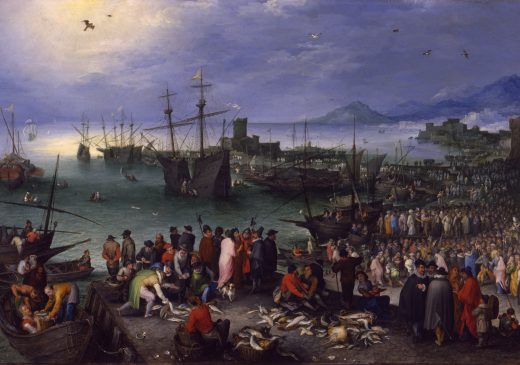Jan Brueghel the Elder was a member of a family of artists (notably his father and his brother). He is known as “the Elder” because his son, also named Jan, became a well-known painter. Brueghel (the Elder) was nicknamed the “Velvet Brueghel” because of his ability to paint fine details. He worked mostly in Antwerp, Belgium, which became a major port city and cultural hub during his lifetime. Jan chose a wide and varied range of subject matter for his pictures, including still lifes, landscapes, allegorical and mythological subjects, and religious scenes. He was a prominent member of the painters’ guild and a close friend and collaborator with Peter Paul Rubens.
Jan Brueghel (also Bruegel or Breughel) the Elder (, also US: ; Dutch: [ˈjɑn ˈbrøːɣəl] ; 1568 – 13 January 1625) was a Flemish painter and draughtsman. He was the son of the eminent Flemish Renaissance painter Pieter Bruegel the Elder. A close friend and frequent collaborator with Peter Paul Rubens, the two artists were the leading Flemish painters in the first three decades of the 17th century.
Brueghel worked in many genres including history paintings, flower still lifes, allegorical and mythological scenes, landscapes and seascapes, hunting pieces, village scenes, battle scenes and scenes of hellfire and the underworld. He was an important innovator who invented new types of paintings such as flower garland paintings, paradise landscapes, and gallery paintings in the first quarter of the 17th century. He further created genre paintings that were imitations, pastiches and reworkings of his father's works, in particular his father's genre scenes and landscapes with peasants. Brueghel represented the type of the pictor doctus, the erudite painter whose works are informed by the religious motifs and aspirations of the Catholic Counter-Reformation as well as the scientific revolution with its interest in accurate description and classification. He was court painter of the Archduke and Duchess Albrecht and Isabella, the governors of the Habsburg Netherlands.
The artist was nicknamed "Velvet" Brueghel, "Flower" Brueghel, and "Paradise" Brueghel. The first is believed to have been given him because of his mastery in the rendering of fabrics. The second nickname is a reference to his fame as a painter of (although not a specialist in) flower pieces and the last one to his invention of the genre of the paradise landscape. His brother Pieter Brueghel the Younger was traditionally nicknamed "de helse Brueghel" or "Hell Brueghel" because it was believed he was the author of a number of paintings with fantastic depictions of fire and grotesque imagery. These paintings have now been reattributed to Jan Brueghel the Elder.


